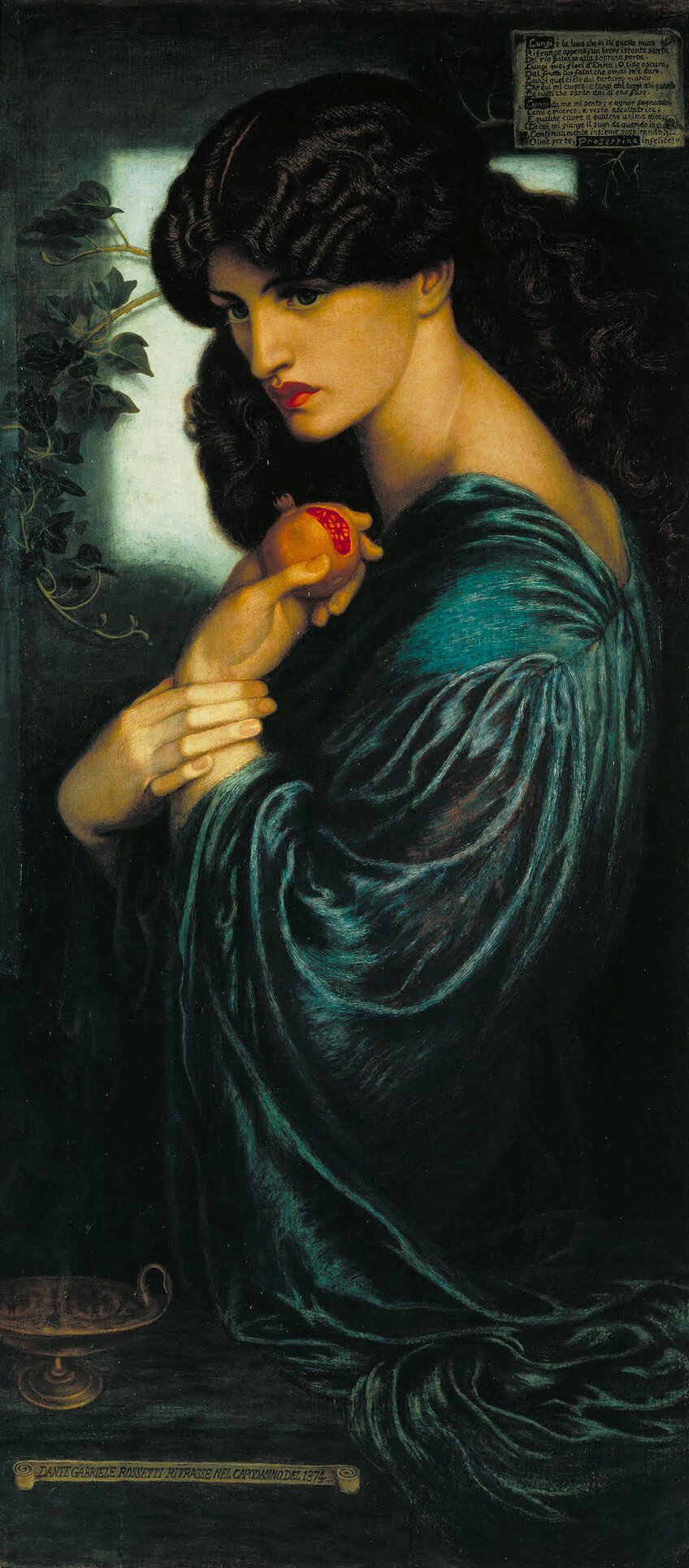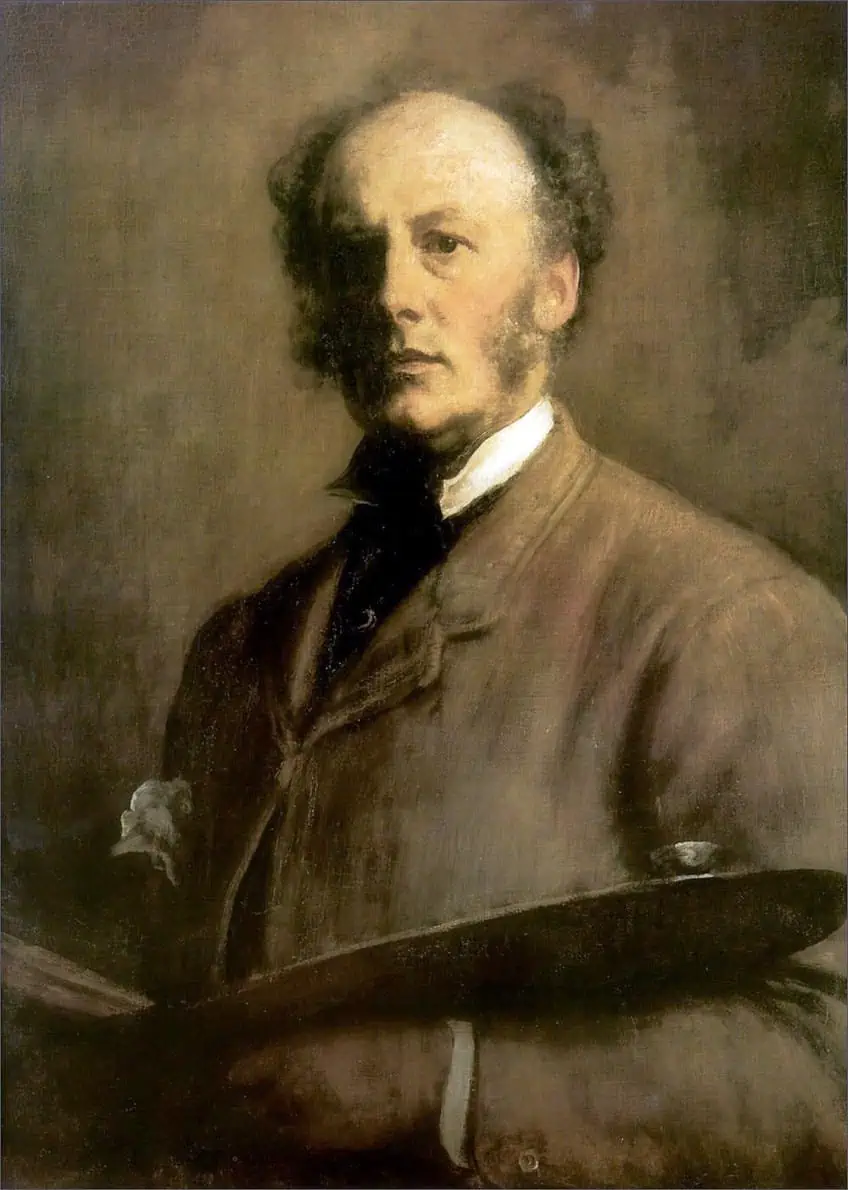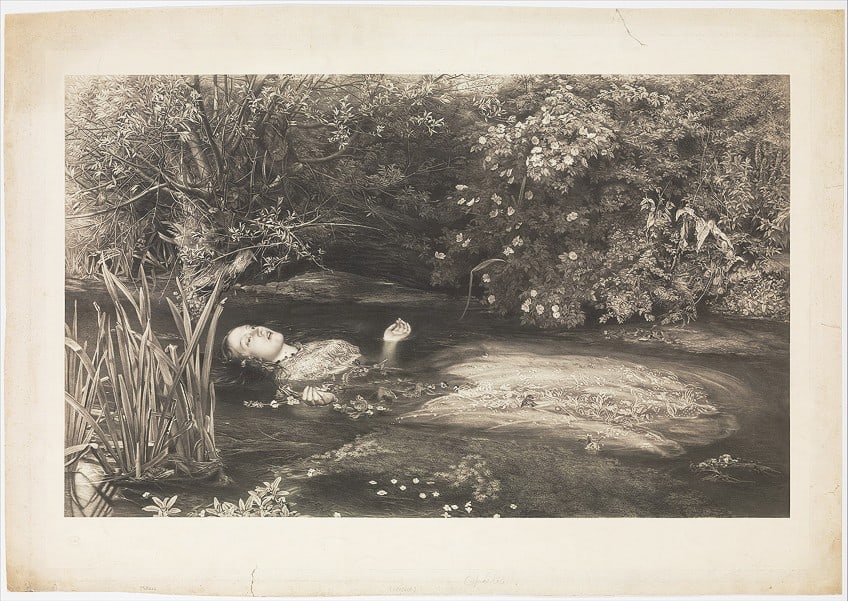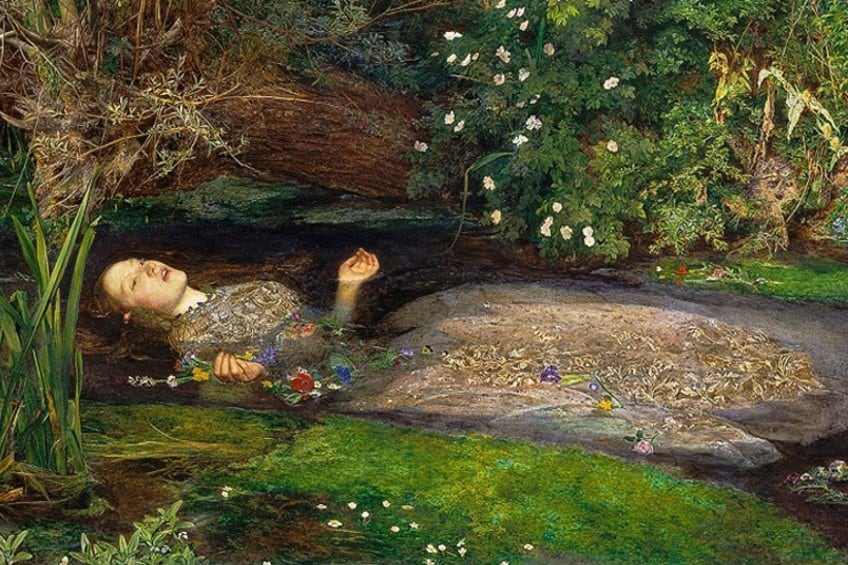“Ophelia” by John Everett Millais – Discover the Woman in the River
Ophelia by John Everett Millais is regarded as one of the most iconic masterpieces produced in the 19th century. The Ophelia drowning painting is based on the story of Ophelia, as told in Shakespeare’s Hamlet. This Pre-Raphaelite painting of Ophelia in the water is now part of the Tate Britain Museum’s collection of art. This article will explore the story of Ophelia and the background of the Ophelia drowning painting.
The Story of Ophelia by John Everett Millais
| Artist | John Everett Millais (1829 – 1896) |
| Date Completed | 1851 – 1852 |
| Medium | Oil on canvas |
| Dimensions (cm) | 76 x 111 |
| Location | Tate Britain, London, United Kingdom |
This famous Pre-Raphaelite painting portrays Ophelia floating downstream at the moment just before she drowns. When the painting of Ophelia in the water was first exhibited at the Royal Academy, it was met with a mixed response. Yet, over time, it has grown to become regarded as one of the 19th century’s most significant works due to its accurate portrayal of nature and its influence on a wide range of artists, from Friedrich Heyser to Salvador Dalí, who were all captivated by its beauty. However, before we examine its beauty and influence any further, we first need to understand the context in which it was created – the Pre-Raphaelite era of painting.
The Pre-Raphaelite Brotherhood
Along with Dante Gabriel Rossetti and William Holman Hunt, John Everett Millais created the Pre-Raphaelite Brotherhood, a group of English artists, poets, and art critics, in 1848. In a visual sense, this brotherhood was influenced by Michelangelo’s historical techniques and Classical poses, but their philosophical approach was completely centered on imitation and admiration of the medieval aesthetic.
At a certain point, the Pre-Raphaelites were divided into two groups, with one group obsessed with the medieval period – castle ruins, abandoned temples, and occult practices, while the other group produced a much more realistic style.

John Ruskin, a noted art critic, admired the Brotherhood for their dedication to the portrayal of nature and the use of unconventional compositional approaches. Yet, John Everett Millais eventually drifted away from medieval art replication, and in the early 1860s, he decided to abandon Pre-Raphaelitism in favor of a far looser style inspired by the artist Sir Joshua Reynolds.
The Story of Ophelia
Before we describe the painting, let’s first learn more about the subject of the painting, Ophelia. Ophelia is a fictional character from Hamlet, one of Shakespeare’s famous dramas. She is a young aristocratic woman, the daughter of Polonius, who goes insane as a result of her lover Hamlet’s deeds and subsequently drowns in a river. Ophelia was well-liked by many people and was extremely obedient to her father. She was kind to all people and exuded innocence. She was, however, also very naive and did whatever her father asked her to do.
Hamlet and Ophelia were initially very much in love, but their relationship began to suffer as Hamlet’s behavior grew unpredictable after his father’s death.

Hamlet, driven by grief and rage, began to withdraw from Ophelia. Polonius, Ophelia’s father, believed that Hamlet’s insanity was the result of his love for Ophelia. He urged Ophelia to stay away from Hamlet and to turn down any advances he made. Ophelia, caught between her feelings for Hamlet and her devotion to her father, took her father’s advice. Polonius was then unintentionally slain by Hamlet while hidden behind a curtain. Ophelia then went mad as a result of her father’s death and her destroyed relationship with Hamlet.
She sang songs in fragments and scattered flowers, symbolizing her deteriorating state of mind.
The Elements and Themes of Ophelia by John Everett Millais
The scene pictured in the painting of Ophelia in the water is not performed on stage since it occurs solely in a description of the event by a character called Gertrude in Shakespeare’s drama. Ophelia had been making wildflower garlands out of sorrow for her circumstances.
A bough snapped beneath her when she climbed into a willow tree spanning the river to drape some garlands from its limbs. She then just lay in the river, singing songs, oblivious to the dangers present.
Due to the air trapped in her garments, she kept floating for a while, but they eventually became too laden with water, and she eventually sank into the muddy waters. Ophelia’s demise has been celebrated as one of literature’s most eloquently penned death scenes. Ophelia’s posture, with her arms open and her skyward gaze, is similar to typical representations of martyrs or saints, yet it has also been interpreted as sensual.
Elements
This artwork is well-known for its representation of the riverbank’s detailed vegetation, illustrating the cycles of growth and death in the natural environment. Despite its formal Danish setting, the scenery is typically regarded as being quintessentially English. Millais created the Ophelia painting beside the Hogsmill River in Surrey. Barbara Webb, a neighboring Old Malden resident, spent a significant amount of time investigating the actual location where the painting was made, and based on her research, the location in question can be found alongside Church Road at Six Acre Meadow in Old Malden.
The floating flowers in the painting were chosen to correlate with the description of Ophelia’s garlands as written by Shakespeare.
They also illustrate the Victorian obsession with the “language of flowers,” which claims that each flower has a specific symbolic meaning. The large red poppy, however, is not included in Shakespeare’s portrayal of the scene and symbolizes sleep and death. Millais initially painted a water vole paddling next to her in the early stages of the painting’s creation which his assistant had caught out of the Hogsmill. He displayed the incomplete artwork to Holman Hunt’s relatives in late 1851.

When asked to figure out what it was, the male relative immediately said it was a hare, followed by a dog or a cat. Millais subsequently removed the water vole from the finished painting, but a rough drawing of it can still be found in the upper corner of the canvas covered by the frame.
Millais followed the Pre-Raphaelite Brotherhood’s principles by using vivid colors, paying close attention to detail, and being true to nature.
The subject matter, representing a female who has lived a life seeking bliss, only to meet her fate on the point of death (the helpless woman is a common topic among Pre-Raphaelite artists), makes this representation of Ophelia the quintessential Pre-Raphaelite painting. Millais also used rich, strong colors in the countryside to contrast the pale Ophelia with the environment behind her. All of this can be observed in the shrubbery and trees around Ophelia, the curves of her face, and the delicate and intricate treatment of her clothing.
Description
Today, the Ophelia painting is on display in Tate Britain’s Room 1840 and draws a lot of interest, thanks to its exceptionally intricate brushwork and the unbelievably devastated expression still evident on Ophelia’s youthful and pale face, lips still open from the fragmentary songs she sang as she began to sink and drown. Ophelia’s body appears to float in the water, largely submerged, with just her neck, face, hands, and breasts visible above the surface, as well as some of the folds of her beautiful gown.
The audience can clearly sense the weight of the cloth as it floats, but also serves to drag her down, as she is dressed in an antique dress that the artist bought specifically for the purpose of making this painting.
Her hair floats in the water around her face, emphasizing her lost youth, and her hands are subserviently raised palm up, barely protruding out of the water’s surface. The overall effect is of fatigued defeat: she has not struggled but embraced her death, demonstrated by the position of her hands, which symbolize surrender. Ophelia’s deathly fate stands in stark contrast to the lush vegetation surrounding her. Although the abundance of colored flowers appears to be present solely for providing color to the landscape, Millais put a lot of thought into this artwork by carefully acquiring symbolic flowers – all of which were meticulously replicated to be botanically accurate.

Roses represent Ophelia’s brother’s nickname for her, “Rose of May”, while nettles, willows, and daisies represent abandoned love, anguish, and innocence. Millais also added more flowers as allusions to Hamlet, while others were added to express significance to a Victorian audience fascinated by floral symbolism. For example, the pansies represent futile love, but the necklace of violets around Ophelia’s neck represents loyalty, purity, and death. It depicts both summer and spring flowers growing side to one another, reflecting the five months of dusk-till-dawn painting that the artist undertook.
The picture contrasts rich natural hues with Ophelia’s gentle skin tones. The vivid greens provide a sense of lush, unkempt nature. When it comes to the color temperature of the painting, the lights look somewhat warmer than the darks.
This is especially noticeable in the greens: the greens in darkness are significantly closer to a blue tone than the greens in light. Ophelia is painted in delicate, faint hues. She looks very fragile as she floats toward her muddy demise. Her face and hands are highlighted with light tones, bringing your attention to these areas. Her face is partly framed by the surrounding nature, with the brown tree trunk and limbs at the top, the plants sprouting up from the stream to the left, and the green border of the bank at the bottom.
The Painting Process of Ophelia
Millais created the Ophelia drowning painting in two stages: the first stage was creating the background landscape and the second stage was creating Ophelia herself. Millais worked for six days a week, typically up to 11 hours every day, over a period of five months in 1851 on the Hogsmill River banks in Ewell, a small distance from where William Holman Hunt, a fellow Pre-Raphaelite artist, produced The Light of the World (1854). This enabled him to portray the natural world in front of him properly. Throughout the painting process, Millais encountered a number of challenges.
In a letter to a friend, he complained that the flies in Surrey had a proclivity for penetrating human flesh. He was also dealing with a summons to present himself before a magistrate for apparently trespassing on a private field and damaging the hay, and he was also constantly at risk of being blown into the lake by severe gusts of wind.
The weather had turned stormy and snowy by November 1851. Millais ordered the construction of a straw-covered hut, which so impressed William Holman Hunt, that he had one made for himself too. Elizabeth Siddall, a 19-year-old muse and artist, served as the model for Ophelia. Millais had her recline completely clothed in a bathtub at his London studio. As it was winter at that time, he set oil lights beneath the tub to help warm up the bath water, but he was so preoccupied with the painting that they went out.

Consequently, Siddall developed a terrible cold, and her father subsequently wrote a letter to the artist, requesting £50 for medical expenses that he had incurred. Millais’s son alleges that he ultimately agreed to a lower amount. There is a cruel irony in Elizabeth Siddal and Ophelia’s lives: both were severely depressed women who committed suicide, forced to live with the agony of losing a loved one. In February 1862, suffering from postpartum depression after her daughter’s miscarriage and hooked on opium, Siddal swallowed a huge quantity of laudanum during a depressive episode – whether purposefully or unintentionally – and passed away several days later.
As a result, once the audience becomes aware of what occurred to the model, Millais’ Ophelia, a depiction of a young lady about to die, feels almost like a premonition.
Reception to Ophelia by John Everett Millais
Ophelia received very mixed reviews when it was originally publicly displayed at London’s Royal Academy in 1852. While it may be hard for us to understand today, when Millais premiered the painting in 1852, some reviewers were outraged. The Pre-Raphaelites’ representations of their models horrified Victorian sensibilities. One critic said that the open mouth was babyish and gaping grotesquely.
One critic felt that there was something weirdly perverse in a mind that portrayed Ophelia in an overgrown ditch, robbing the tragic struggle of that sorrowful maiden of all poignancy and elegance.
Even the famous art critic John Ruskin, usually an ardent Millais follower, voiced reservations about his decision of setting the painting in a location in Surrey and asked why he chose to paint in a wire-fenced garden rather than pure nature. Salvador Dalí spoke enthusiastically about the creative movement that influenced the artwork in a 1936 edition of Minotaure, a French Surrealist journal. In 1906, Japanese author Natsume Sseki described the work of art as “an object of remarkable beauty” in his novel Kusamakura; the work of art has been famous in Japan ever since. It appeared in Tokyo in an exhibition in 1998 and returned there for another one in 2008.
How Artworks Such As Ophelia Helped Change Beauty Standards
The English artist Joshua Reynolds highlighted the importance of the artist attempting to idealize nature, particularly images of feminine beauty. Instead, the Pre-Raphaelites selected atypical figures with thick hair, hooded eyes, and big lips. These women’s brazen appearances enraged Victorian audiences, whose standards of beauty and elegance promoted being delicate and submissive.
Pre-Raphaelite figures like Siddal were seen as being muscular, openly sexualized, and evidently less wealthy (or lower class). However, by the 1870s, these characteristics were generally embraced in artistic circles.
Within barely 20 years, the painters had transformed how we viewed beauty. As iconoclasts, all of them broke through various form and style restrictions, revising the insipidity that defines modern beauty and replacing it with a more unwavering, unsentimental, though extravagantly individualized vision.
Significance of the Artist and Artwork
Sir John Everett Millais was a well-known English artist who made a vital contribution to the formation of the Pre-Raphaelite movement with his creative techniques and aesthetic vision. Millais started his creative career at an early age, enrolling in the Royal Academy Schools at the age of 11 and becoming the school’s youngest student ever. He immediately became known for his technical ability and exceptional attention to detail.
Millais was instrumental in developing the Pre-Raphaelite movement’s beliefs and style. The Brotherhood aspired to make works that were brilliant in color, detailed, and focused on symbolism and nature.

Millais’ paintings embodied these features, helping to establish the Pre-Raphaelite school as a major influence in the art world. Millais received recognition for his technical abilities as well as his capacity to represent minute details. His artwork had a great level of realism, with light, texture, and elements of nature captured with great accuracy. His meticulous approach impacted future generations of painters, who respected his dedication to achieving lifelike depictions of the surrounding natural world.
The Legacy of Ophelia by John Everett Millais
With its emphasis on emotion, nature, and the examination of the individual’s inner world, this painting epitomizes the spirit of Romanticism. It also combines symbolic elements, such as the flowers and their associated significance, which assisted in increasing the popularity of symbolism in art in the Victorian era. It challenged established aesthetic standards and narrative frameworks. The divergence from classical composition and unusual depiction of something tragic allowed artists to explore new modes of visual expression and storytelling.
Ophelia has entered popular culture, with references, recreations, and parodies appearing in different kinds of media. It has influenced literary works, stage shows, and even music. Ophelia floating on the water has become an iconic symbol in our culture associated with beauty, sorrow, and despair.

It inspired a sequence in The Last House on the Left (1972) film by Wes Craven, and the video for Where the Wild Roses Grow by Nick Cave has Kylie Minogue imitating the painting. The artwork is also mentioned in Fire With Fire (1986), a film in which a schoolgirl emulates the scene when the characters meet. The painting’s theme is referenced in the prologue to Melancholia (2011) by Lars von Trier, in which Justine can be seen floating in a slow-moving river stream.
That wraps up our article on Ophelia by John Everett Millais. The tragic drowning of Ophelia from William Shakespeare’s Hamlet is portrayed in John Everett Millais’s stunningly realistic artwork, Ophelia. Elizabeth Siddal, a Pre-Raphaelite model, was made to remain in a bathtub of water for hours at a time, which was kept heated by lights beneath. On one occasion, she suffered from a severe cold due to the lights going out. Not only did Millais paint indoors, but also spent months outdoors in the wind and cold, fighting bugs and warrants to continue painting the background scene for his painting of Ophelia in the water.
Take a look at our Ophelia painting webstory here!
Frequently Asked Questions
Who Was Ophelia?
Ophelia is portrayed as a youthful and innocent noblewoman in William Shakespeare’s tragedy, Hamlet. She initially shares a love relationship with Hamlet, but their bond falls apart as a result of Hamlet’s erratic actions upon the passing of his father and his mother’s quick engagement to Claudius, his uncle. Throughout the play, Ophelia’s character experiences a drastic shift. She is divided between her father’s wishes for her to stay away from Hamlet and her love for him. Ophelia’s state of mind deteriorates as the story proceeds. Shattered by the loss of her father and her ruined relationship, she eventually goes insane.
What Is Portrayed in Ophelia by John Everett Millais?
In this famous Pre-Raphaelite painting by Millais, we see Ophelia floating on her back downstream as she sings songs in broken fragments. Around her, we can see flowers which all carry symbolic significance. She is wearing a beautiful antique gown which was bought by Millais specifically for the creation of the painting of Ophelia in the water. Despite being a very well-renowned artwork today, when it was first shown in an exhibit, it was met with a very mixed reception. However, it was later recognized for its role in changing beauty standards in society and art.
Jordan Anthony is a Cape Town-based film photographer, curator, and arts writer. She holds a Bachelor of Art in Fine Arts from the University of the Witwatersrand, Johannesburg, where she explored themes like healing, identity, dreams, and intuitive creation in her Contemporary art practice. Jordan has collaborated with various local art institutions, including the KZNSA Gallery in Durban, the Turbine Art Fair, and the Wits Art Museum. Her photography focuses on abstract color manipulations, portraiture, candid shots, and urban landscapes. She’s intrigued by philosophy, memory, and esotericism, drawing inspiration from Surrealism, Fluxus, and ancient civilizations, as well as childhood influences and found objects. Jordan is working for artfilemagazine since 2022 and writes blog posts about art history and photography.
Learn more about Jordan Anthony and about us.
Cite this Article
Jordan, Anthony, ““Ophelia” by John Everett Millais – Discover the Woman in the River.” artfilemagazine – Your Online Art Source. September 8, 2023. URL: https://artfilemagazine.com/ophelia-by-john-everett-millais/
Anthony, J. (2023, 8 September). “Ophelia” by John Everett Millais – Discover the Woman in the River. artfilemagazine – Your Online Art Source. https://artfilemagazine.com/ophelia-by-john-everett-millais/
Anthony, Jordan. ““Ophelia” by John Everett Millais – Discover the Woman in the River.” artfilemagazine – Your Online Art Source, September 8, 2023. https://artfilemagazine.com/ophelia-by-john-everett-millais/.



